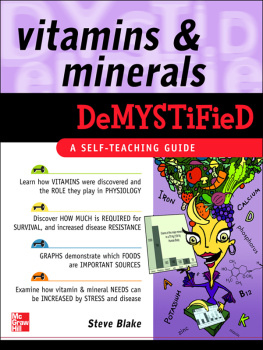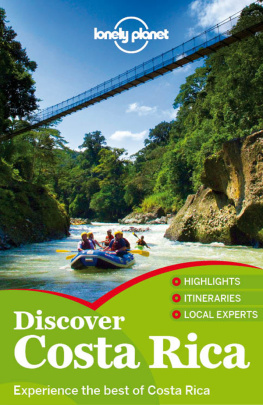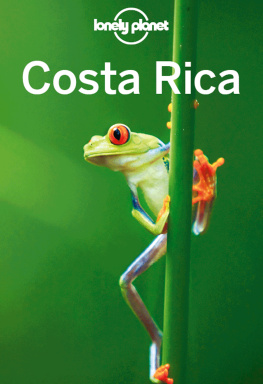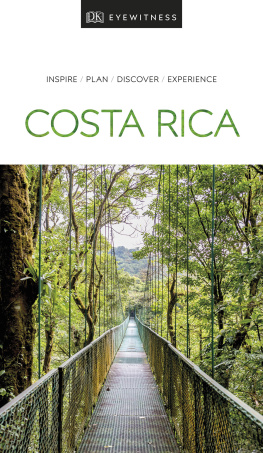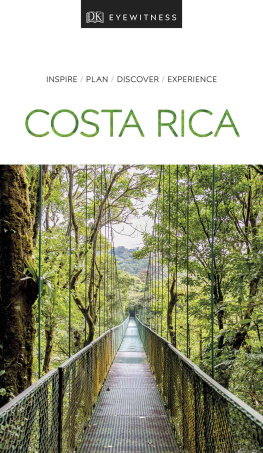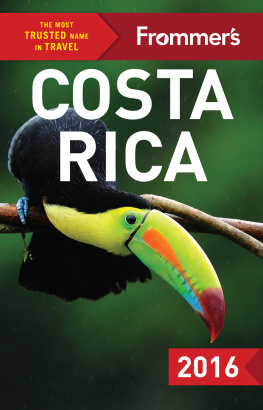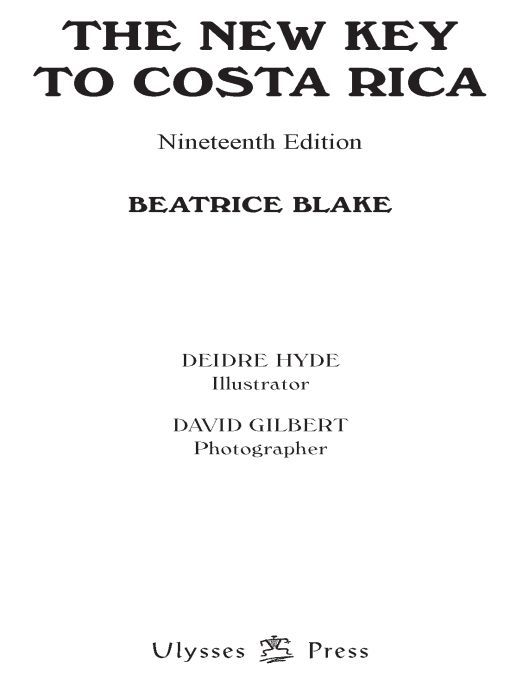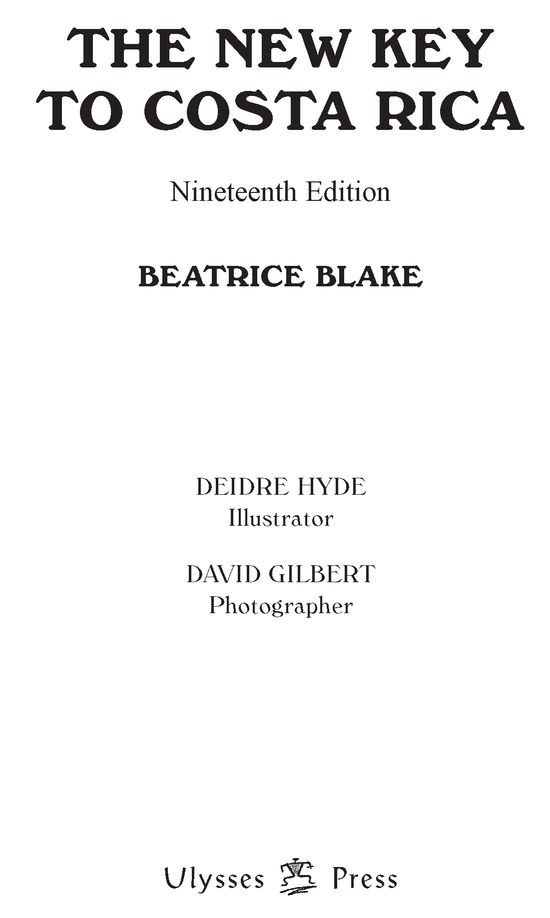Table of Contents
THE NEW KEY TO COSTA RICA
The Best.
Atlanta Journal-Constitution
Brings the traveler closer to the local culture.
San Antonio Express-News
Costa Ricas oldest guidebook remains the best! Its full of nuggets not found in the dozens of wannabesinformation on ecotourism and local communities, cultural traditions, and out of the way adventures. Like no other writer, Beatrice Blake knows all of Costa Ricas nooks and crannies.
Martha Honey, Ph.D., Executive Director of The International Ecotourism Society (TIES)
Why is The New Key to Costa Rica one of Planeta.coms all-time favorite books? It places environmental conservation, biodiversity and responsible tourism in the spotlight with practical tips for the traveler. Highly recommended.
Ron Mader, host of planeta.com
The latest edition of The New Key to Costa Rica sets the standard for environmentally and socially responsible tourism guides. As well as a comprehensive wealth of great information on destinations, it also includes sections on community-based ecotourism.
Andy Drumm, Director, Ecotourism Program, The Nature Conservancy
For peace with justice in harmony with nature
Acknowledgments
Many thanks to Kyra Cruz, Eva Arauz, Karine Chardon and all the members of ACTUAR for facilitating much of my research.
Much thanks goes out to Eladio Salazar of Coopesavegre, Hernan Ramirez of Nacientes Palmichal, Daniel and Dominique of Sueo Celeste, and Roy Meza of ACTUAR. Each of you greatly expanded my knowledge of your areas and provided great companionship during my research. It was also fun to travel with Joan and George Packard while they were producing a fascinating video about ACTUAR destinations. Alex Murray of Casa Maana and Emma Harrison, scientific director of the Caribbean Conservation Corps, generously took time to orient me with their expertise.
Thanks also to old friends Deirdre Hyde, Robert Lee, John and Sue Trostle, and Margaret Smith Adelman for fun and companionship. This edition could not have happened without the collaboration and friendship of Heidi Daub and Elena Arias. I cant thank you enough!
Thanks to all the readers who sent me their comments. Your feedback is a boon to all your fellow travelers.
Happy 52nd anniversary to the Tico Times, one of the bravest little papers on the planet, for their in-depth coverage of political, social, and environmental issues in Costa Rica.
The year 2008 marks the 32nd anniversary of The Key to Costa Rica, which my mother, Jean Wallace, started in 1976. Bless her for her joyful and generous spirit and the love of Costa Rica that inspired this book. This year also marks the 22nd anniversary of my collaboration and redesigning of this book with Anne Becher. Even though she was not involved in this edition, her words, spirit, and values still pervade the book, and we wish her well in her busy life as mother, professor, and freelance writer.
Thanks to my family for their love and support while I put out yet another edition.
Thanks to the staff at Ulysses Press for their ability to whip this manuscript into a user-friendly guide.
Beatrice Blake
October 2008
Innovative Communities and Your Vacation
In many of the projects highlighted in this edition, organic agriculture, appropriate energy technology, and preservation of forests and rivers are combined with tourism in a way that holds great promise for the future. By visiting these communities, you will not only meet some lovely people, but you will be inspired by their ability to put innovative principles into practice. You will also see the results of the intelligent, dedicated work of the United National Development Program, COOPRENA, ACTUAR, and individual social entrepreneurs, who, in a time of worldwide chaos, are faithfully sowing the seeds of peace.
THE EVOLUTION OF CONSERVATION AND ECOTOURISM IN COSTA RICA
Because it contains 4 percent of global biodiversity in its very small territory, Costa Rica has been a mecca for tropical biologists and ecologists for the last 50 years. These scientists worked with visionary Costa Ricans to establish the famous National Parks Service in the 1970s. As protected areas were established and research was carried out, biologists observed that most animals migrate from one altitude to another during the year. Researchers discovered that many wild felines like panthers, jaguars, and pumas need hundreds of square miles of habitat in order to hunt and reproduce successfully. In fact, they have found that, in order for large cats to sustain their populations, each species requires a preserve big enough to support at least 500 to 5000 individuals of each species. If, through careless development, the original habitat is degraded into small, isolated pieces, the cats, and less charismatic animals, birds and insects, rapidly face extinction.
This awareness led to the creation of more and more parks and protected areas during the 1980s. The National Parks Service began a concerted effort to teach environmental education in the schools. Costa Rica also made a decision to rely on its biodiversity to attract tourism, instead of becoming yet another fun-and-sun tropical destination. Word spread, and soon Costa Ricans were seeing that their commitment to the protection of nature was providing jobs and opportunities for advancement.
At the same time, farmers who were struggling to make ends meet saw the tourism boom around them, and often decided to sell their farms in order to get funds to build tourist lodging, or to sell to foreigners who were paying exaggerated prices for land. Often foreigners knew how to establish and publicize nature tourism to people in North America and Europe, making for successful businesses. Setting up a B&B or an ecolodge became a dream for many foreigners who migrated here. Costa Rican families with large tracts of land also set up reserves to preserve wildlife habitats and gain government protection against squatters. Conservationists, farmers, and loggers often found themselves in a bitter race to gain control of the countrys remaining unprotected forests.
In the early 1990s, area governments entertained the idea of the Paseo Pantera (Panthers Path): an unbroken strand of protected forest lands stretching along the Caribbean coast of Central America which would guarantee the range that wild animals need in order to survive. Although this project was funded by a consortium of conservation organizations, it floundered in the face of opposition from indigenous and campesino groups. Indigenous lands often have extensive forests, and governments have rarely been concerned with giving native people legal title to them. Poor farmers often lacked title as well. Both groups were aware of Central American history, in which elites have taken the most desirable land and pushed native people out. They feared a land grab that would banish them, once again, from their homes.
With time, even strict conservationists came to see that it was unnecessary to prohibit all human activity in order to preserve nature. They also began to understand that large tracts of land could never be assembled if the needs of local residents were not met.
In 1994, Costa Rica conducted a thorough survey of its richest ecosystems to determine how to conserve its remaining biodiversity. But the government, with 25 percent of national territory under some kind of protection, could not afford to buy and maintain more land. The government acknowledged that many privately owned reserves supported conservation by forming buffer zones and biological corridors around and between existing national parks. In 1995, the National System of Conservation Areas (SINAC) was formed. This divides the country into 11 conservation areas, ignoring provincial boundaries and concentrating on related ecosystems. In each area, private- and state-owned conservation activities are interrelated. SINACs goals are to manage and promote the sustainable use of natural resources along with economic and social development.



